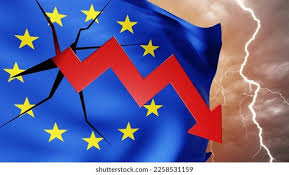
Economic momentum across Europe is showing signs of faltering as the full impact of U.S. tariffs begins to reverberate through trade networks and political instability in France continues to unsettle markets. While some regions of the eurozone have maintained modest growth, mounting pressures suggest that the bloc may be heading toward a sharper slowdown than previously expected. Analysts warn that both external trade pressures and internal political turmoil are converging to threaten the stability of Europe’s largest economies.
Germany has so far been the primary driver of eurozone growth, with strong government spending and fiscal expansion offsetting weaknesses elsewhere. However, this temporary boost is masking deeper structural vulnerabilities. Exporters are grappling with higher costs imposed by U.S. tariffs, while uncertainty in France is discouraging investment and consumer spending, creating a complex environment that may slow the overall eurozone expansion.
Trade Frictions and U.S. Tariffs: A Pressing Threat
The introduction of U.S. tariffs on European goods has begun to take a tangible toll on eurozone industries. Exports, particularly in the automotive and machinery sectors, are facing increased costs, leading to lower competitiveness in key American markets. Many companies have initially absorbed tariff costs through profit margins, but analysts note that these measures are unsustainable in the long run. Rising production costs and reduced export volumes are expected to erode corporate profitability, creating knock-on effects for investment and employment.
The Organisation for Economic Co-operation and Development (OECD) projects that these trade tensions will reduce eurozone GDP growth from 1.2% this year to 1.0% next year. Beyond slowing growth, tariffs are also contributing to uncertainty across the business environment. Firms report declining new orders from abroad, and confidence indices indicate a retreat in manufacturing sentiment, suggesting that the eurozone has yet to feel the full brunt of trade-related pressures.
Beyond direct trade costs, U.S. tariffs are exacerbating broader supply chain challenges. European firms reliant on imported components are facing disruptions and higher input costs, which are ultimately passed on to consumers. Analysts argue that unless trade tensions ease, the region could see a prolonged period of slower growth, particularly in countries heavily dependent on exports to the U.S. market.
French Political Instability Amplifies Economic Weakness
Political turmoil in France is emerging as a significant factor in the eurozone slowdown. Heightened uncertainty surrounding government leadership, ongoing resistance to fiscal reforms, and public unrest are weighing heavily on business and consumer confidence. The French economy has contracted for 13 consecutive months, and recent data indicate the sharpest decline in activity since early 2024. Economic analysts point to the combination of political gridlock and policy uncertainty as a deterrent to investment, further weakening the broader European growth outlook.
The repercussions of France’s instability extend beyond its borders. Neighboring economies, closely tied through trade and financial links, are experiencing secondary effects from weaker French demand and heightened market uncertainty. Investment projects that span multiple eurozone countries are being reassessed or delayed, as businesses seek to minimize risk exposure. Economists warn that if the political situation in France remains unresolved, the ripple effects could slow growth across much of the bloc.
Public-sector constraints and social unrest are also suppressing domestic consumption in France. High inflation and stagnant wages are reducing household spending, further limiting economic growth. The European Central Bank and regional policymakers are closely monitoring the situation, as prolonged French instability could necessitate targeted interventions to prevent a broader eurozone downturn.
Germany’s Fiscal Expansion: Short-Term Support, Long-Term Limits
Germany has acted as a stabilizing force within the eurozone, largely due to its fiscal stimulus measures. Government spending and targeted economic programs have supported domestic demand and boosted business confidence, reflected in a temporary uptick in Germany’s Purchasing Managers’ Index (PMI) to a 16-month high. However, economists caution that this growth is largely stimulus-driven rather than stemming from underlying private sector expansion, raising questions about sustainability once fiscal measures taper.
While Germany’s fiscal expansion offers a buffer against immediate shocks, trade-related pressures and regional instability mean the country cannot fully insulate the eurozone from slowdown risks. Exporters face the same U.S. tariff constraints as elsewhere, and investment sentiment is increasingly influenced by political developments in France and other Southern European economies. Analysts emphasize that Germany’s role as an economic engine may be insufficient to counteract broader eurozone weakness if external pressures persist.
Furthermore, policymakers in Germany are weighing future fiscal consolidation measures, which could temper growth in the medium term. The OECD warns that while current stimulus supports economic activity, anticipated budgetary adjustments combined with external shocks could reduce growth to 1.0% across the eurozone by next year. This signals that Germany’s temporary strength cannot fully offset systemic vulnerabilities in other major economies.
Inflation Pressures and Monetary Policy Challenges
Amid slowing growth, inflation remains a persistent concern across Europe. Core inflation is projected to hover around 4.2% next year, well above the European Central Bank’s target. This dual challenge of stagnating growth and elevated prices presents a dilemma for policymakers, who must balance the need to curb inflation against the risk of further slowing economic activity.
The ECB is navigating a narrow policy path. Although lower interest rates and potential monetary easing could support domestic consumption, continued inflationary pressure may limit the scope for aggressive stimulus. Analysts stress that achieving a delicate equilibrium is critical; missteps could either exacerbate price instability or intensify the economic slowdown.
In this environment, both fiscal and monetary policymakers are under pressure to coordinate responses. Targeted interventions, such as investment incentives and temporary trade support measures, are being discussed to mitigate the negative impacts of tariffs and political instability. The ability of European leaders to act decisively will influence whether the bloc can maintain resilience or succumbs to a deeper slowdown in the coming months.
(Source:www.reuters.com)
Germany has so far been the primary driver of eurozone growth, with strong government spending and fiscal expansion offsetting weaknesses elsewhere. However, this temporary boost is masking deeper structural vulnerabilities. Exporters are grappling with higher costs imposed by U.S. tariffs, while uncertainty in France is discouraging investment and consumer spending, creating a complex environment that may slow the overall eurozone expansion.
Trade Frictions and U.S. Tariffs: A Pressing Threat
The introduction of U.S. tariffs on European goods has begun to take a tangible toll on eurozone industries. Exports, particularly in the automotive and machinery sectors, are facing increased costs, leading to lower competitiveness in key American markets. Many companies have initially absorbed tariff costs through profit margins, but analysts note that these measures are unsustainable in the long run. Rising production costs and reduced export volumes are expected to erode corporate profitability, creating knock-on effects for investment and employment.
The Organisation for Economic Co-operation and Development (OECD) projects that these trade tensions will reduce eurozone GDP growth from 1.2% this year to 1.0% next year. Beyond slowing growth, tariffs are also contributing to uncertainty across the business environment. Firms report declining new orders from abroad, and confidence indices indicate a retreat in manufacturing sentiment, suggesting that the eurozone has yet to feel the full brunt of trade-related pressures.
Beyond direct trade costs, U.S. tariffs are exacerbating broader supply chain challenges. European firms reliant on imported components are facing disruptions and higher input costs, which are ultimately passed on to consumers. Analysts argue that unless trade tensions ease, the region could see a prolonged period of slower growth, particularly in countries heavily dependent on exports to the U.S. market.
French Political Instability Amplifies Economic Weakness
Political turmoil in France is emerging as a significant factor in the eurozone slowdown. Heightened uncertainty surrounding government leadership, ongoing resistance to fiscal reforms, and public unrest are weighing heavily on business and consumer confidence. The French economy has contracted for 13 consecutive months, and recent data indicate the sharpest decline in activity since early 2024. Economic analysts point to the combination of political gridlock and policy uncertainty as a deterrent to investment, further weakening the broader European growth outlook.
The repercussions of France’s instability extend beyond its borders. Neighboring economies, closely tied through trade and financial links, are experiencing secondary effects from weaker French demand and heightened market uncertainty. Investment projects that span multiple eurozone countries are being reassessed or delayed, as businesses seek to minimize risk exposure. Economists warn that if the political situation in France remains unresolved, the ripple effects could slow growth across much of the bloc.
Public-sector constraints and social unrest are also suppressing domestic consumption in France. High inflation and stagnant wages are reducing household spending, further limiting economic growth. The European Central Bank and regional policymakers are closely monitoring the situation, as prolonged French instability could necessitate targeted interventions to prevent a broader eurozone downturn.
Germany’s Fiscal Expansion: Short-Term Support, Long-Term Limits
Germany has acted as a stabilizing force within the eurozone, largely due to its fiscal stimulus measures. Government spending and targeted economic programs have supported domestic demand and boosted business confidence, reflected in a temporary uptick in Germany’s Purchasing Managers’ Index (PMI) to a 16-month high. However, economists caution that this growth is largely stimulus-driven rather than stemming from underlying private sector expansion, raising questions about sustainability once fiscal measures taper.
While Germany’s fiscal expansion offers a buffer against immediate shocks, trade-related pressures and regional instability mean the country cannot fully insulate the eurozone from slowdown risks. Exporters face the same U.S. tariff constraints as elsewhere, and investment sentiment is increasingly influenced by political developments in France and other Southern European economies. Analysts emphasize that Germany’s role as an economic engine may be insufficient to counteract broader eurozone weakness if external pressures persist.
Furthermore, policymakers in Germany are weighing future fiscal consolidation measures, which could temper growth in the medium term. The OECD warns that while current stimulus supports economic activity, anticipated budgetary adjustments combined with external shocks could reduce growth to 1.0% across the eurozone by next year. This signals that Germany’s temporary strength cannot fully offset systemic vulnerabilities in other major economies.
Inflation Pressures and Monetary Policy Challenges
Amid slowing growth, inflation remains a persistent concern across Europe. Core inflation is projected to hover around 4.2% next year, well above the European Central Bank’s target. This dual challenge of stagnating growth and elevated prices presents a dilemma for policymakers, who must balance the need to curb inflation against the risk of further slowing economic activity.
The ECB is navigating a narrow policy path. Although lower interest rates and potential monetary easing could support domestic consumption, continued inflationary pressure may limit the scope for aggressive stimulus. Analysts stress that achieving a delicate equilibrium is critical; missteps could either exacerbate price instability or intensify the economic slowdown.
In this environment, both fiscal and monetary policymakers are under pressure to coordinate responses. Targeted interventions, such as investment incentives and temporary trade support measures, are being discussed to mitigate the negative impacts of tariffs and political instability. The ability of European leaders to act decisively will influence whether the bloc can maintain resilience or succumbs to a deeper slowdown in the coming months.
(Source:www.reuters.com)





